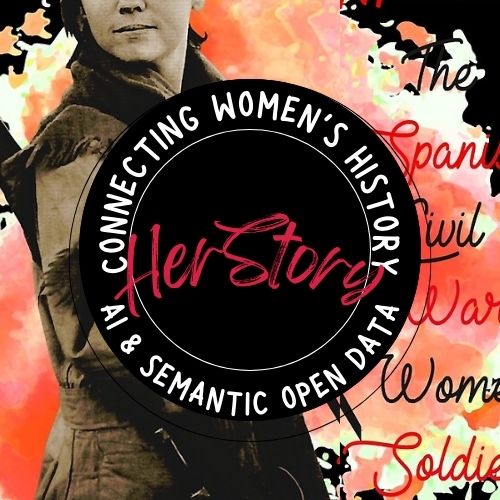
Connecting women’s history to Neuro-Symbolic AI: An Information Architecture approach to Francoist repression case study (HerStory&NeSyAI) PID2023-147673OB-I00
“Vinculando la historia de las mujeres a la IA Neuro-Simbólica: Enfoque de Arquitectura de la Información para el estudio de caso de represión franquista” (HerStory&NeSyAI)
100.000€ Ministerio de Ciencia, Innovación y Universidad 3 anys.
IP: Núria Ferran-Ferrer.
This project aims to enhance theoretical knowledge of Information Architecture (IA) using an artificial intelligence-driven system (AI) to enrich creation and reading of marginalized narratives. It aims to address the societal challenge of the gender gap in data use and information retrieval, particularly concerning women and marginalized gender identities in media content, to foster a more inclusive and equitable public sphere. The contribution is that the information will not only be provided with structured data or linear information but also enriched cognitive and emotional readings.
The main objective is to improve the dissemination of information with narrative generation through the enhancement of IA services (for searching, navigation, organization and labelling), incorporating knowledge generated in recent years by the information, communication and computation disciplines –especially with the application of AI), as well as co-created knowledge from specific communities and user groups, in both cases to avoid gender biases. This involves training IA systems and implementing a model for semantically enriched linked open data publication, for the subsequent operability of Neuro-Symbolic Artificial Intelligence (NeSyAI).
Specifically, focusing on the case study of Francoist repression and censorship with gender lens, the project involves community participation in real-needs-based data gathering, prototyping and testing to showcase the practical application of this approach in contemporary open knowledge information systems. Following the principles of citizen science, with a novel approach termed ‘citizen digital humanities‘, the project engages volunteer activist groups on gender issues in Wikipedia and Wikidata, along with volunteers knowledgeable about Spanish repression during the Francoist period.
The general objective of this project is to improve the data dissemination, use and knowledge generation about women and minoritized gender identities and mitigate gender bias in artificial intelligence systems applied to information systems. By shedding light on marginalized narratives, the project endeavours to foster a more inclusive understanding of historical contributions, thereby contributing to dismantling of stereotypes and promoting a broader societal perspective Digital Humanities (DH).
HerStory is structured into 5 layers and 3 research objectives with their respective specific objectives.
Layer A: Conceptualization
O1: Updating the Information Architecture (IA) definition with the incorporation of Neuro-Symbolic Artificial Intelligence (NeSy AI) adopting a gender perspective with intersectionalities.
SO1.1. To analyse the influence of NeSy AI, on reshaping the contemporary understanding and definition of the concept of IA.
SO1.2. To explore best practices and standards for integrating gender and intersectional perspectives into IA, for examining the role of NeSy AI in addressing related challenges, and for assessing the impact on analyzing DH cases, such as Francoist Repression and Censorship.
SO1.3. Develop ethical and legal guidelines for the responsible use of advanced IA in exploring sensitive topics (e.g., repression, censorship and gender identities or other intersectional issues) and representing minoritized gender identities.
SO1.4. Define the objectives and scope of a NeSy AI system and gain a comprehensive understanding of the DH domain, including identifying types of data, formulating relevant research questions, and elucidating prevalent challenges within the DH.
Layer B: Design
O2: Design gender-inclusive NeSy AI prototypes to improve IA services (navigation, search, organization, labelling, and visualization) for both editor/admin and reader users in the DH domain.
SO 2.1: Collect and analyse user behaviour and needs by employing an UCD approach to understand and enhance user experience that meets gender and intersectionalities requirements.
SO 2.2: Design and apply processes to transform scenario datasets into open linked data (knowledge graph), utilizing semantic web standards and technologies, specifically RDF.
SO 2.3: Determine the specifications of a neural network that meets the project’s requirements, such as avoiding gender biases, taking into consideration both user needs and behaviours, as well as DH datasets.
Layer C: Development
SO.2.4. Train the neural network (i.e. the language model) using the knowledge graph developed through the transformation process.
SO.2.5. Implement NeSy AI reasoning mechanisms to allow the system to derive conclusions that involve both symbolic and subsymbolic knowledge.
SO.2.6. Integrate symbolic and neural components.
SO.2.7. Evaluate the NeSy AI system through user feedback and iterative processes, emphasizing aspects of explainability, interpretability, UX and ethical considerations.
SO.2.8. Implement co-creation strategies to evaluate the user experience of AI conversational interactions.
S0 2.9. Design information visualization models based on the structural and semantic features of the DH datasets integrated in the developed NeSy AI assistant.
Layer D: Implementation and use in case study
O3: Applying and assessing the framework of advanced information architecture to scenarios related to Francoist repression and censorship with a gender and intersectional perspective.
SO.3.1. Assess the co-created application of advanced IA services (enriched with NeSy AI system) for analysing and connecting uncovered narratives related to gender, repression and censorship during the Francoist era.
Layer E: Co-created citizen science (transversal)
SO3.2. Explore the impact of an ethically tailored NeSy IA system on citizen science in Digital Humanities, focusing on Francoist repression data, particularly related to women and intersectional issues.
SO3.3. Identify and investigate additional co-created outcomes for community-driven research and testing in participatory HCI.
- Description of the methodology
The HerStory project employs a multidisciplinary methodological approach, capitalizing on the diverse expertise of its research team, which spans information science, communication, law, co-creation and history. This collaborative effort incorporates a cross-cutting discipline in computer science. The methodological framework embraces a qualitative perspective, adapting and combining for user testing and participatory research techniques such as focus groups (Lazar et al., 2017), co-creation sessions (Sanders and Stappers, 2008), scoping reviews (Booth et al., 2012), Delphi (Landeta et al., 2011), contextual interviews (Holtzblatt and Beyer, 1997), netnography (Kozinets, 2012) and participant observation (Kawulich, 2005). Additionally, a quantitative perspective will be employed, involving the application of data mining and analysis techniques on user behaviour logs (Martín et al., 2021), heuristic evaluations (Nielsen, 1995), and data visualisation methodologies (Cui, 2019). This methodological approach ensures a comprehensive and holistic investigation, combining qualitative insights with quantitative analyses to gain a nuanced understanding of the complexities surrounding the project’s objectives.
The research design adopts an action research approach, merging co-created citizen science (Follett and Strezov, 2015) with user-centered design methodologies, in order to foster micro-projects across varied scenarios based on 5 digital humanities initiatives, each containing personal data related to repression and censorship during the Francoist period. This thoughtful amalgamation of initiatives, each driven by unique motivations, historical knowledge, and technical expertise, forms a robust foundation for the research design, ensuring a comprehensive exploration of personal data related to repression and censorship during the Francoist period.
Within this comprehensive framework, three databases are curated by team researchers who are integral members of the research or work team, and two from members of the work team:
- Censorship databases led by Dr. Ivan García and professor Miquel Centelles, from the CeLRu project (PID2020-116868GB-I00), from HerStory scientific and work team.
- International brigades (SIDBRINT Database) and is overseen by Dr. Lourdes Prades, from work team.
- Mass graves and is spearheaded by Dra. Queralt Solé, Dra. Lourdes Prades from UB and Director General de Memòria Democràtica, Alfons Aragoneses.
- Judicial processes of the dictatorship, is a collaborative effort by Innovación y Derechos Humanos – IHR led by Concha Catalán and Martin Vitel, both in the work team.
- Repression at UB, involves the institutional motivation from UB to restore historical memory, with Núria Cañellas representing the UB archive and Rosa Fabeiro from the UB library, in the team work.
- The Italian intervention in the Merindades area, Burgos: material legacy, oral memory, and collective memory of the Civil War and the Dictatorship, a project by the Gea Cultura Association directed by Dr. Amalia Pérez-Juez Gil and funded by the Secretariat, with Dr. Octavi Torres, from work team.
